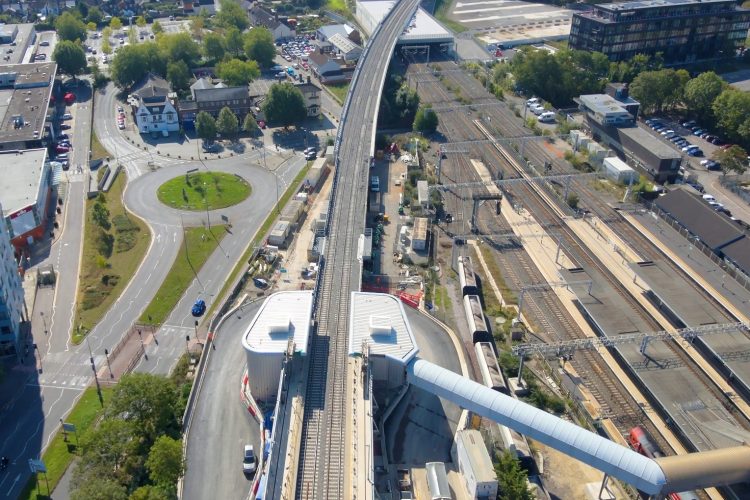Jez Baldock talks about the successes of East West Rail Phase 2
Posted: 13 November 2023 | | No comments yet
East West Rail (EWR) is not just a transport project, it provides wider economic benefits, including thousands of jobs and homes within England’s Economic Heartland. The scheme aims to deliver much-needed connections for communities between Oxford and Cambridge, creating a new radial transport route that will make travel more efficient.


A first phase was completed in 2016 and connects Oxford Parkway to Bicester. The £1.bn section known as EWR Phase 2 (which supports Connection Stage 1 services between Oxford and Milton Keynes Central) is being delivered on time and under budget by the EWR Alliance, demonstrating that the UK can deliver large and complex transport projects. We sat down with Jez Baldock, AtkinsRéalis Engineering Director for Transport – UK & Europe, to find out why this project has been successful and what the industry can learn.
What is AtkinsRéalis’ role on the EWR2 programme and who else is involved?
AtkinsRéalis is part of an alliance delivering the EWR2 programme, alongside Network Rail (NR), Laing O’Rourke and VolkerRail. We have collaborated previously and reuniting this alliance has been integral to the success of the project. It means we’ve moved a high performing and close-knit team from one project to another and we can continue learning together.
EWR2 is one of AtkinsRéalis’ biggest UK transport projects and we are leading the design and consultancy work – anything from ecology, town and country planning, archaeology and transport works orders, to the design of stations, track and bridges. We also bring project management experience and engineering leadership to deliver the project on the ground, as well as our signalling and telecoms delivery expertise.
What has helped EWR2 get to where it is today?
It has to be the Alliance’s way of working. We have skillsets that complement each other and a proven track record of strong collaboration, such as the Stafford Area Improvement project.
NR committed to deploying a pure Alliance contract from the outset, meaning while they have a seat at the table, the Alliance had, and still has, autonomy to make decisions for the benefit of the programme. I think this has been key to its success.
One example of the Alliance working well together was the Bletchley Viaduct. The alliance utilised its breadth of skills to make a bold change of scope, ultimately creating a product that was lower risk, lower cost and resulted in a better asset for NR.
Has the programme encountered any challenges along the way and how did the teams resolve them?
Planning the construction around the ecology along the project route was the big challenge. The 20-mile stretch of railway had become a wildlife haven for protected species and animals such as badgers, bats, otters, great crested newts and barn owls. We had to take account of the complex ecology calendar, which informs you when species can and cannot be disturbed. It has taken effective planning, collaboration with stakeholders and nature experts such as Nature England, and agile decision-making to ensure we worked hand-in-hand with
Secondly, the rural location meant it was imperative that we minimised disruption to residents, ensuring roads were in top condition after we completed construction. The project also presented opportunities to give back to the local communities. Over the programme, we’ve delivered a return on investment of £3m through our social value activities – from painting fences in local schools and community centres, to delivering first aid and safety training and educating students and Scout groups on railway safety, among other charity work. The Alliance is grateful to the communities we worked in for their continued patience as construction progressed.
Finally, we had to ensure this new railway was futureproofed for both passengers and freight. To that end, we installed AtkinsRéalis’ Advanced Signalling Method (ASM), which is a digital-ready solution that can be integrated and upgraded to ETCS at any point in the future.
What can the rail (and wider) industry learn from the delivery of EWR to inform and improve future projects and programmes?
Whatever the team, you need to choose the right people and roles (including the client), with the right culture and trust them to deliver what the project needs from start to finish. That’s exactly what NR have done on EWR2, resulting in a project that is on track to be delivered on time and under budget. The setup is relatively simple where the Alliance is responsible for all delivery and the majority of risks, under a single contract.
What’s next for the programme?
We’ll be completing the infrastructure-ready phase of Connection Stage 1 (CS1 – Oxford to Milton Keynes) in 2024, ready for the service to go into operation sometime after that. CS2 and CS3 further east towards Bedford & Cambridge are future phases, which are due to go to Statutory Consultation in 2024 by the EWR Company.
The alliance itself will be looking for the next opportunity to bring our joint experience and learnings to another successful rail project. We are looking to bid for some future programmes together and I’m excited about what the future holds. Creating high-performing, agile, collaborative teams that deliver the best outcomes – it’s what every project should strive for.





